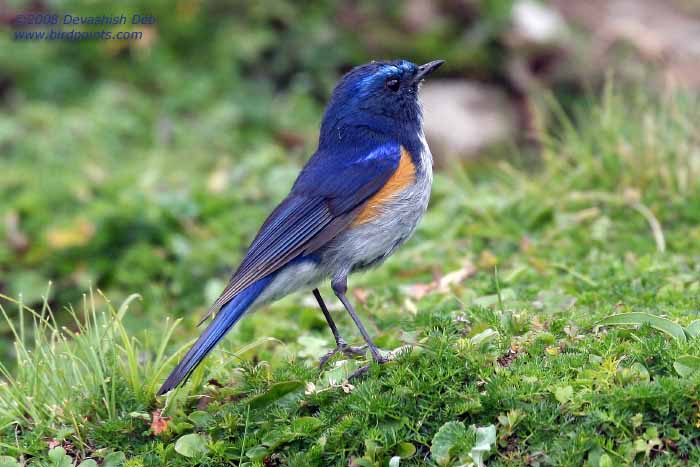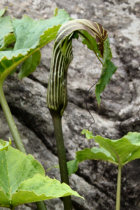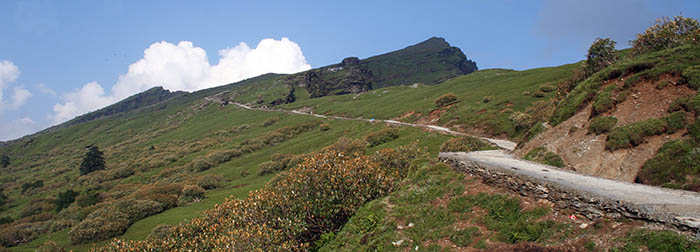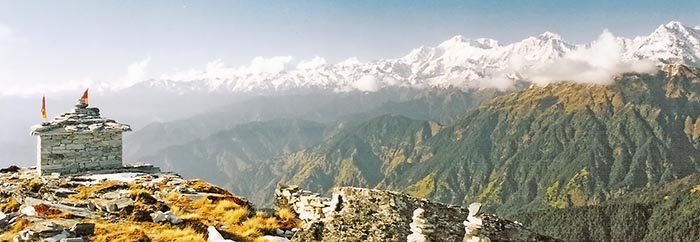Chopta it is if you want to be “far from the madding crowd's ignoble strife”
and enjoy the magnificent views of the Himalaya from the alpine meadows.
Chopta lies between Kedarnath and Badrinath, at an edge of Kedarnath Wildlife
Sanctuary, to the north central part of Uttaranchal. Uttaranchal is now Uttarakhand
which was formed out the state of Uttar Pradesh in India on 9 November 2000,
and is also known as Dev Bhumi.
The motor-able route: Delhi - Merrut Bypass - Mujaffarnagar Bypass - Haridwar
- Rishikesh bypass - Devprayag - Srinagar - Rudraprayag and left fork towards
Kedarnath - Drive along river Mandakini (and not crossing the river at Kund)
- Ookhimath (has a GMVN rest house) - Dugalbetta - Chopta.
The checklist of birds has been compiled for the area of study as below, along
with the height from sea level:

Makkumath ~2100m
Dugalbetta ~2350m
Banyakund ~2600m
Chopta ~2700-3000m (30°29'N latitude and 79°10'E longitude)
Bujgwali ~3100m
Devdarshani ~3500m
Tunganath ~3680m
Chandrashila ~3750m
The distance from Makkumath to Dugalbetta is 8 Kms, next to Chopta is another
12 Kms, and a trek from Chopta to Tunganath is 3 Kms and after 1 more Km is
Chandrashila. As can be seen from above, there is a rapid change of altitude
in a short distance.
This region belongs to the Temperate zone where, in winters, most of this
area is covered in snow and in the higher reaches the temperature can plummet
to -15C. During Monsoons the area receives almost 2000 mm of rain so landslides
etc. can be a deterrent. The local tea shops etc. are open from 30th April
to 20th Oct. at Chopta.
The habitat can broadly be termed as Quercus forest ~2600m, Rhododendron forest
~3000m, grasslands ~3400m. I have found that the Rhododendron can be an altitude
marker. At Makkumath, Rhododendron arboreum (Red flowers) is found. At Chopta,
R. barbetum (Pink flowers). At treeline near Devdarshini, R. Campanulatum
(white flowers). At Tunganath, the shrubs of R. anthopogon. At Chandrashila,
R. lepidotum etc. The flowering period is April/May only.

The
whole region shows immense biodiversity. Many varieties of Lichens grow here
on wood, soil and rock substrates. The Cobra Plant, Arisaema utile, always manages
to catch your attention. The plants and herbs found here are used for traditional
healthcare medicines, beverages (the flowers of Rhododendron arboreum, locals
call it "Burans", gives the Rhododendron juice), dyes and insecticides etc.
The fibers of these plants are also used for handicrafts, ropes, mats, baskets
and sports items etc.
The broad mix of trees here mainly consist of Oak (Quercus semecarpifolia),
Rhododendron, Yew (Taxus baccata), Himalayan Fir (Abies pindrow), Deodar (Cedrus
deodara) etc.
Many wild animals are found here. Himalayan Black Bear, Leopard, Wild Boar,
Jackal, Fox, Jungle Cat, Marbled Cat, Himalayan Langur, Yellow-throated Marten, Pika, Himalayan Tahr,
Ghoral, Barking Deer and others offer evidence of their presence. A Musk Deer
reserve is also present 7 Kms further towards Mandal.

800 mts before Tunganath, Chandrashila peak center rt
From Chandrashila one gets the magnificent panoramic views of Kedar Peak,
Kedar Dome, Mount Shivling, Chaukhamba, Nandadevi, Nanda Ghunti, Hathi Parvat,
Ghodi Parvat, Dronagiri, Mandani, Trisul, Panchachuli etc.
A few Terrabits:
Near this area in 1796, Major General Thomas Hardwicke (click here for an image
of
Spiny-tailed
Lizard named in his honour), was the first to collect plants and shrubs.
The Himalayan Sheep Dog remains silent, almost always, but growls when it
senses a leopard in the area.
A Snow Leopard was reported from Chopta in 1979.
Mispronunciation often means Rhodo-dodo-dendron.
Mahishanand Maithani, nearly 90 yrs of age, daily treks the steep climb up
and down from Chopta to Tungnath.
Bhuk Hartal (literally "Hunger Strike") bus service is the lifeline here.
'Kadik Bam' is the most photographed person at Tunganath and appears in many
posters advertising Uttarakhand.

Chandrashila
The feel:
At the first colour of dawn and the effort of the birds, I started on the kilometer long trek to Chandrashila. Having spent many years in the Himalaya, I was no stranger to the lofty peaks, but must confess that I was awestruck by the magnificent scene on the first view from Chandrashila. It easily surpassed my expectation. Just a few ranges of low forest-covered mountains stood between me and the marbled white mass of the peaks, covering the entire panorama. As I scanned the skyline, the haze of the east gave way to the clear northern peaks of Chaukhamba and others. They all look so near and the skyward peaks climb against a blue sky. The low hung pieces of cloud were floating still hereabouts. Moments before the rising sun became visible, the peaks turned golden-yellow and soon sun-ray shafts pierced the sky, partly creating a halo around Nanda Devi and neighboring peaks. This is how early morning expresses "Himadri", the permanent snowy peaks.
As the day progresses, the low recesses become warm and the stagnancy gets broken.
The keenly outlined mist, dense and heavy at times, white mostly, springs up
from the void of the intervening forest range, only to unite amongst themselves
at the summits, grow further and ascend higher up. The onlooker soon starts
losing sight of the exceptional scenery noticeable moments ago. Nature’s magic
wand waved everyday, a curtain to every bliss.
Some philosophy:
The beauty of this place cannot be described at all. There are only feelings and some clues to solving the mystery. But first, let the stiffness go, if you have come this far, it has probably already gone. At Chandrashila, as you touch the sky, you are at the center of the magical orb. Be there in the early morn, see the sun in Taurus rise and feel the cadence. At first the vast physical emptiness looks monstrous but soon enough you know that the stillness is an illusion. The charm overflows and all reach the "pure mind of a sage".
Back to the checklist(Beta):
Himalayan Swiftlet,
Collocalia brevirostris - Tunganath
Crested Goshawk,
Accipiter trivirgatus - Banyakund
Besra,
Accipiter virgatus
- Banyakund
Long-legged Buzzard,
Buteo rufinus - Banyakund
Lammergeier,
Gypaetus barbatus - Tunganath
Himalayan Griffon,
Gyps himalayensis - Banyakund to Tunganath
Black Kite,
Milvus migrans - Banyakund
Red-headed Vulture,
Sarcogyps calvus - Banyakund
Mountain Hawk Eagle,
Spizaetus nipalensis - Makkumath
Common Kestrel,
Falco tinnunculus - Makkumath
Golden Eagle,
Aquila chrysaetos - Tunganath
Speckled Wood Pigeon,
Columba hodgsonii - Chopta
Snow Pigeon,
Columba leuconota - Tunganath
Spotted Dove,
Streptopelia chinensis - Chopta
Oriental Turtle Dove,
Streptopelia orientalis - Chopta
Hill Partridge,
Arborophila torqueola - Makkumath
Snow Partridge,
Lerwa lerwa - Tunganath
Himalayan Monal,
Lophophorus impejanus - Tunganath
Kalij Pheasant,
Lophura leucomelanos - Makkumath
Koklass Pheasant,
Pucrasia macrolopha - Chopta
Black-throated Tit,
Aegithalos concinnus - Makkumath
Bar-tailed Treecreeper,
Certhia himalayana - Bujgwali
Rusty-flanked Treecreeper,
Certhia nipalensis - Bujgwali
Winter Wren,
Troglodytes troglodytes - Bujgwali
Hill Prinia,
Prinia atrogularis - Makkumath
Striated Prinia,
Prinia crinigera - Makkumath
Common Raven,
Corvus corax - Tunganath
Large-billed Crow,
Corvus macrorhynchos - Chopta
Ashy Drongo,
Dicrurus leucophaeus - Makkumath
Lesser Racket-tailed Drongo,
Dicrurus remifer - Makkumath
Eurasian Jay,
Garrulus glandarius - Dugalbetta
Black-headed Jay,
Garrulus lanceolatus - Banyakund
Maroon Oriole,
Oriolus
traillii - Makkumath
Long-tailed Minivet,
Pericrocotus ethologus - Chopta
Scarlet Minivet,
Pericrocotus flammeus - Makkumath
Yellow-bellied Fantail,
Rhipidura hypoxantha - Chopta
Yellow-billed Blue Magpie,
Urocissa flavirostris - Dugalbetta
to Chopta
Yellow-breasted Greenfinch,
Carduelis spinoides - Bujgwali
Common Rosefinch,
Carpodacus erythrinus - Tunganath
Dark-breasted Rosefinch,
Carpodacus nipalensis - Tunganath
Rock Bunting,
Emberiza cia - Tunganath
Black-and-yellow Grosbeak,
Mycerobas icterioides - Bujgwali
Red-headed Bullfinch,
Pyrrhula erythrocephala - Devdarshani
Asian House Martin,
Delichon dasypus - Tunganath
White-capped Water Redstart,
Chaimarrornis leucocephalus - Tunganath
Little Forktail,
Enicurus scouleri - Banyakund
Verditer Flycatcher,
Eumyias thalassinus - Chopta
Rufous-gorgeted
Flycatcher,
Ficedula strophiata - Devdarshani
Chestnut-bellied Rock Thrush,
Monticola rufiventris - Banyakund
Rusty-tailed Flycatcher,
Muscicapa ruficauda - Devdarshani
Blue Whistling Thrush,
Myophonus caeruleus - Makkumath to Tunganath
Rufous-bellied Niltava,
Niltava sundara - Chopta
Blue-capped Redstart,
Phoenicurus coeruleocephala - Devdarshani
Blue-fronted Redstart,
Phoenicurus frontalis - Devdarshani
Plumbeous Water Redstart,
Rhyacornis fuliginosa - Banyakund
Grey Bushchat,
Saxicola ferreus - Chopta
Golden Bush Robin,
Tarsiger chrysaeus - Devdarshani
Orange-flanked Bush
Robin,
Tarsiger cyanurus - Devdarshani
White-collared Blackbird,
Turdus albocinctus - Banyakund
Grey-winged Blackbird,
Turdus boulboul - Dugalbetta
Mistle Thrush,
Turdus viscivorus - Chopta
Long-tailed Thrush,
Zoothera dixoni - Chopta
Plain-backed Thrush,
Zoothera mollissima - Chopta
Long-billed Thrush,
Zoothera monticola - Chopta
Mrs Gould's Sunbird,
Aethopyga gouldiae - Chopta
Green-tailed Sunbird,
Aethopyga nipalensis - Bujgwali
Fire-breasted Flowerpecker,
Dicaeum ignipectum - Bujgwali
Grey-crested Tit,
Parus dichrous - Chopta
Great Tit,
Parus major - Makkumath
Spot-winged Tit,
Parus melanolophus - Chopta
Green-backed Tit,
Parus monticolus - Chopta
Grey Wagtail,
Motacilla cinerea - Banyakund
Yellow Wagtail,
Motacilla flava - Chopta
Alpine Accentor,
Prunella collaris - Tunganath
Rufous-breasted Accentor,
Prunella strophiata - Bujgwali
Black Bulbul,
Hypsipetes leucocephalus - Makkumath
Kashmir Nuthatch,
Sitta cashmirensis - Bujgwali
Chestnut-bellied Nuthatch,
Sitta castanea - Makkumath
Wallcreeper,
Tichodroma muraria - Tunganath
Grey-sided Bush Warbler,
Cettia brunnifrons - Tunganath
Spotted Bush
Warbler, Bradypterus thoracicus - Tunganath
Chestnut-crowned Laughingthrush,
Garrulax erythrocephalus -
Dugalbetta
Streaked Laughingthrush,
Garrulax lineatus - Dugalbetta
Striated Laughingthrush,
Garrulax striatus - Makkumath
Variegated Laughingthrush,
Garrulax variegatus - Devdarshani
Rufous Sibia,
Heterophasia capistrata - Banyakund to Chopta
Chestnut-tailed Minla,
Minla strigula - Chopta
Lemon-rumped Warbler,
Phylloscopus chloronotus - Banyakund to
Chopta
Ashy-throated Warbler,
Phylloscopus maculipennis - Banyakund
to Chopta
Hume's Warbler,
Phylloscopus humei - Chopta
White-browed Shrike-Babbler,
Pteruthius flaviscapis - Chopta
Whistler's Warbler,
Seicercus whistleri - Dugalbetta
Grey-hooded Warbler,
Seicercus xanthoschistos - Makkumath to
Dugalbetta
Whiskered Yuhina,
Yuhina
flavicollis - Makkumath
Stripe-throated Yuhina,
Yuhina gularis - Chopta
Great Barbet,
Megalaima virens - Dugalbetta
Rufous Woodpecker,
Celeus brachyurus - Makkumath
Himalayan Woodpecker,
Dendrocopos himalayensis - Banyakund
Rufous-bellied Woodpecker,
Dendrocopos hyperythrus - Makkumath
Scaly-bellied Woodpecker,
Picus squamatus - Tunganath
Slaty-headed Parakeet,
Psittacula himalayana - Makkumath
Common Hoopoe,
Upupa epops - Dugalbetta
***
Info for the tourist:
From Rudraprayag although Chopta can be reached driving along the river Mandakini
via Ookhimath, one can also take the route to Chamoli along the bank of Alaknanda,
take a left turn towards Gopeshwar then to Chopta via Mandal forest.
Staying options; Mandakini (green river) Side:
Ookhimath (GMVN): Also called Ukhimath.
Accommodation at Dugalbitta PWD rest house is difficult to get, the Himalayan
views here are fantastic though. A paying guesthouse also exists at Dugalbitta.
Alaknanda (brown river) Side:
Gopeshwar (GMVN)
Chopta does not have a GMVN guesthouse but basic camps run by the locals may
serve the purpose. It is always chilly at Chopta and above so moderately heavy
woolens are recommended. After acclimatization, the 3Km trek to Tunganath from
Chopta is relatively easy on the wide mule track. After every Km, one can halt
at the teashops to catch one's breath. Very basic staying options are available
at Tunganath for an early morning trek to Chandrashila the next day and back
to Chopta.
The Gharwal Mandal Vikas Nigam (GMVN) (peak season ~Rs. 1050/- per day), guesthouses
can be booked online
here.

 The
whole region shows immense biodiversity. Many varieties of Lichens grow here
on wood, soil and rock substrates. The Cobra Plant, Arisaema utile, always manages
to catch your attention. The plants and herbs found here are used for traditional
healthcare medicines, beverages (the flowers of Rhododendron arboreum, locals
call it "Burans", gives the Rhododendron juice), dyes and insecticides etc.
The fibers of these plants are also used for handicrafts, ropes, mats, baskets
and sports items etc.
The
whole region shows immense biodiversity. Many varieties of Lichens grow here
on wood, soil and rock substrates. The Cobra Plant, Arisaema utile, always manages
to catch your attention. The plants and herbs found here are used for traditional
healthcare medicines, beverages (the flowers of Rhododendron arboreum, locals
call it "Burans", gives the Rhododendron juice), dyes and insecticides etc.
The fibers of these plants are also used for handicrafts, ropes, mats, baskets
and sports items etc. 
